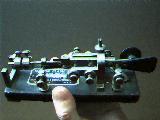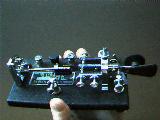Martin Flash Keys


Well, you live and learn. I always had thought that Martin Flash Keys,
made by Martin Research and Manufacturing Corporation in the late 30's and
by Bunnell in the 1940's were still really made by Horace Martin. But, as
I re-read the Vibroplex Collector's Guide by Tom French on page 93 it is
clear that the Martin Flash Keys were made by the sons of Horace
Martin! The Flash Keys are relatively scarce, mainly because they weren't
produced for as long a time as the main line of Vibroplex. An Original,
a Lightning Bug, a Blue Racer, and a Midget were made as Flash keys. There
was even a Piggy-back straight key that could be attached to the wire
terminals of the bug. This photo shows a "Professional No.6" Martin Research and
Manufacturing Corp. Flash Key with the Piggy-back straight key attached.

The workings of this Flash Key with the vertical damper and the post
for a lever arm support are the same as the Martin Midget. This key was
called the "Amateur Flash Key." It is the only Martin key of which I am
aware which has a beveled edge to the base, though it is a little hard to
make out in the photo. This key was made by Bunnell-Martin as the 5-46.

Here is another Martin Research and Manufacturing Flash Key, this time the
"Junior Flash Key" which is the Blue Racer look-alike. Other than the
label, it is a Blue Racer in every respect. This key was also made by Bunnell-Martin as the 5-47.
A circuit is a path through which electrical current can flow from one side of a
battery (or other source of force) to the other. When elements of the circuit are joined
together one after the next in a straight row, they are considered to be in 'series'. Another
way to join them in a circuit is by giving each element its own conductor, such that only
a portion of the total current flows through each element. This is called a 'parallel
circuit'. A resistor is a circuit element whose function is to decrease the voltage (force)
along the path. If resistors are connected in series, the total resistance is the sum
of resistances. If resistances are connected in parallel, the inverse of the total
resistance is the sum of the inverses of the individual resistances. In the diagram,
resistors are shown in red, and the battery in green. Wires are black.
Click on a resistor
to see the parallel version of this circuit.

As you can see, from a distance this bug looks like the Vibroplex Original.
On closer inspection, that is not entirely the case. The support frame
on this bug has a arched cathedral shaped top limb as in Bunnell bugs.
The Vibroplex Originals had either a gently curved or square frame. This
is kind of a hybrid between Bunnell's speed keys and Martin's Original.
This is the Bunnell-Martin 5-48.

This bar graph shows when the Vibroplex models were made in
relationship to each other from 1905 to 1960. Credit to Tom French's
Vibroplex Collector's Guide for the data and the concept.
You may click and drag your mouse across the graph to see which
models were made during which decades. Click the right side of the
applet to display the entire graph again.

 Back to the Index
Back to the Index








 Back to the Index
Back to the Index